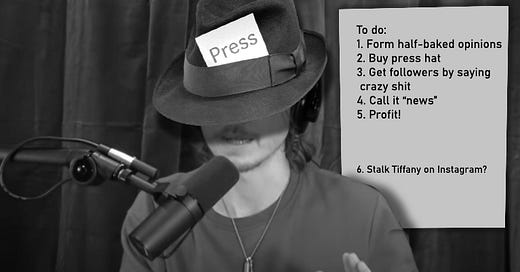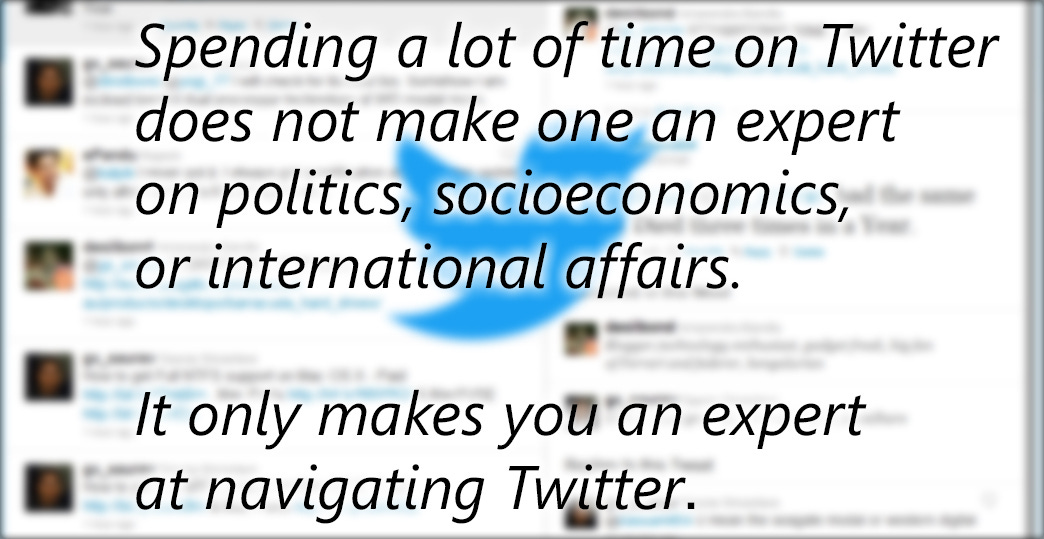Continuing our analysis of what healthy news looks like, it might be helpful to consider some examples of what doesn’t fall into that category. If you’re starting here it might be helpful to read part I and II first:
Part I: In Defense of News
Part II: What News is
Healthy news is not:
Found via Twitter, Reddit, Facebook, Instagram/TikTok/etc.
These sites occasionally link to real news. But they do not have news. Twitter (for example) does not hire journalists or fact-checkers, and the platform as a whole does not prioritize your understanding, only your attention1.
People will say “Don’t get your news from Twitter/Facebook/Reddit” to which other people will respond: “But this is news from a reputable source that was only posted to it!”. Remember social media sites have algorithms of their own, and they are not interested in educating you. Even good stories and sources can be manipulated with dishonest (or algorithmically uncaring) presentation.
News commentary
Most of the best journalistic publications out there include a lot of commentary and analysis with their reporting. This is not necessarily a bad thing. Good journalistic outlets can give added perspective, deeper context, and point out connections to other topics du jour. But commentary is not the news. And for best results™ commentary should only be consumed after you’ve taken time to consider the story itself and your feelings on the topic.
“Talking heads”
Ask yourself why you should care what some television (or radio, or internet) personality thinks? What does it matter what some commentator you don’t personally know feels about the latest headlines? It’s likely they are not an an expert in the topic. By doing the work and thinking for yourself first, you won’t be outsourcing your critical thinking skills to someone unqualified.
Op-eds/Essays etc.
The editorial section is often the place where you’ll find suggestions of how society should be interpreting the news, including non-mainstream perspectives for consideration. But it is also a place where facts can be spun to fit an existing narrative or to prop up tribalist biases. A good op-ed or essay will lay out facts and connect dots to form a rational argument. A healthy editorial page is populated with essays where even if you disagree with the rationale you should be able to “get” where the other person is coming from.
Most of the op-eds and essays online today are… not that. But even the ones that are healthy, are still not news. They’ll often sit next to the news, and are dressed up in the same colors as news. They can have catchy headlines that grab your eye, but they ain’t news.
A headline
“Don’t just read the headline” is advice repeated often, but rarely taken even by the best of us. It is mankind’s natural inclination to keep scrolling until we “get the gist” of all that is happening and develop a God’s eye perspective of what’s out there. Not only is that perspective impossible even if everyone in the information ecosystem was being honest all the time, but much (most?) of what’s our there is written by dishonest agenda-pushing actors, or sensationalist ones merely trying to appease the mysterious algorithm.
When asked recently if “nuanced debate” is possible on Twitter, comedian Jon Stewart replied:
It’s hard because, unfortunately right now, the real conversations that take place for people aren’t based on other conversations. They’re based on encapsulation and synopses and headlines of those conversations. What we’re talking about right now doesn’t travel in the same way that a headline, “Stewart says [Tucker] Carlson is a traitor” or, “Stewart defends blah blah blah”.
Often a simple quote is used as a headline (usually formatted plainly as “So-and-so: ‘such and such’.”). These are often done with minimal context, or with the context buried in the article with the understanding that most people aren’t reading the full article. This technique is seen more widely in less scrupulous publications as a means to push an agenda while avoiding accusations of dishonesty. Celebrity gossip tabloids are also infamous for fabricating entire “beefs” whole-cloth, using out of context quotes. It is rare that a quote by itself is sufficient information be considered news.
Talk shows/podcasts
Back in the 2000s nearly one third of Americans under 40 saw “The Daily Show” and “Colbert Report” as alternatives to traditional news. This doesn’t appear as true today, and one could make the argument that the availability of healthy news options at the time was limited. But even if Jon Stewart and Stephen Colbert were trusted, it was made obvious that they were only satirizing news anchors, not claiming to be them.
Today- we have unlimited commentary podcasts that will spin the news to fit any ideology, even if that ideology is “don’t trust journalists”. And many of these hosts are claiming to be journalists, even if their practices aren’t exactly aligned with the Journalistic Code of Ethics. This makes it easy for the listener to fall into the trap of hearing only what you want to hear, or allowing yourself to believe that what you’re hearing is presented responsibility. Like all commentary, it should only be consumed long after you have given your brain time to process the original story.
No news is better than unhealthy news. Being honest about your own ignorance is better than the false belief that you are knowledgeable in areas where you are not. But something not being news does not imply that it’s a waste of time. When keeping one’s head straight it’s important to make the distinction in what you’re consuming. Many of us want to believe that “low-fat” processed foods are healthy, when often they have a lot of added sugar. Many of us want to believe that by skimming headlines presented to us on social media that we are understanding a wide swath of current events. It is only by first being honest with ourselves and our limitations that we can begin to look at what we’re feeding out heads with.
Further reading: Part I: In Defense of News, Part II: What News is
The argument could be made that Twitter profits indirectly from a lack of fact checking. If it’s users feeling confused and overwhelmed, those emotions increase short-term anxiety-reducing behaviors such as mindless scrolling on one’s phone.








